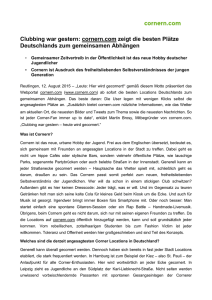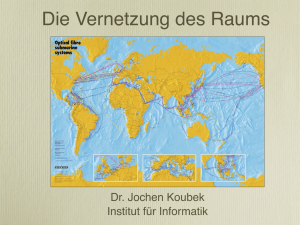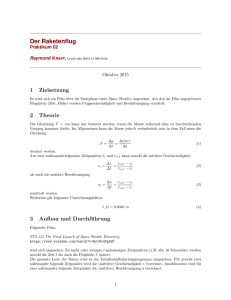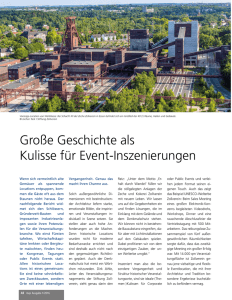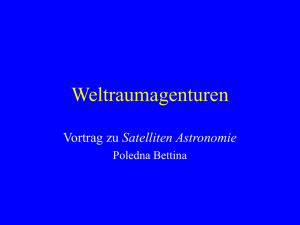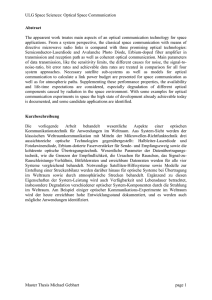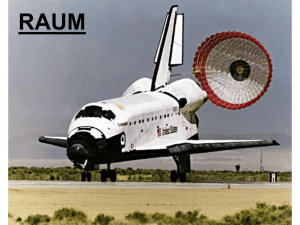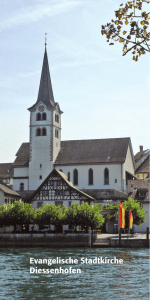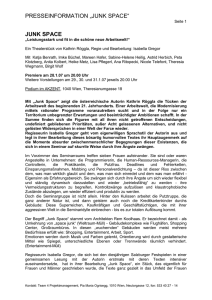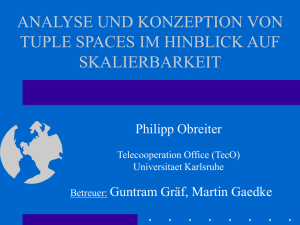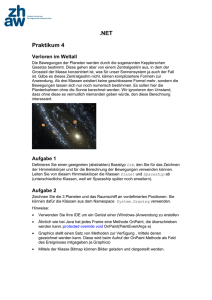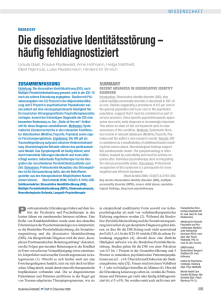on dis/place/ment
Werbung
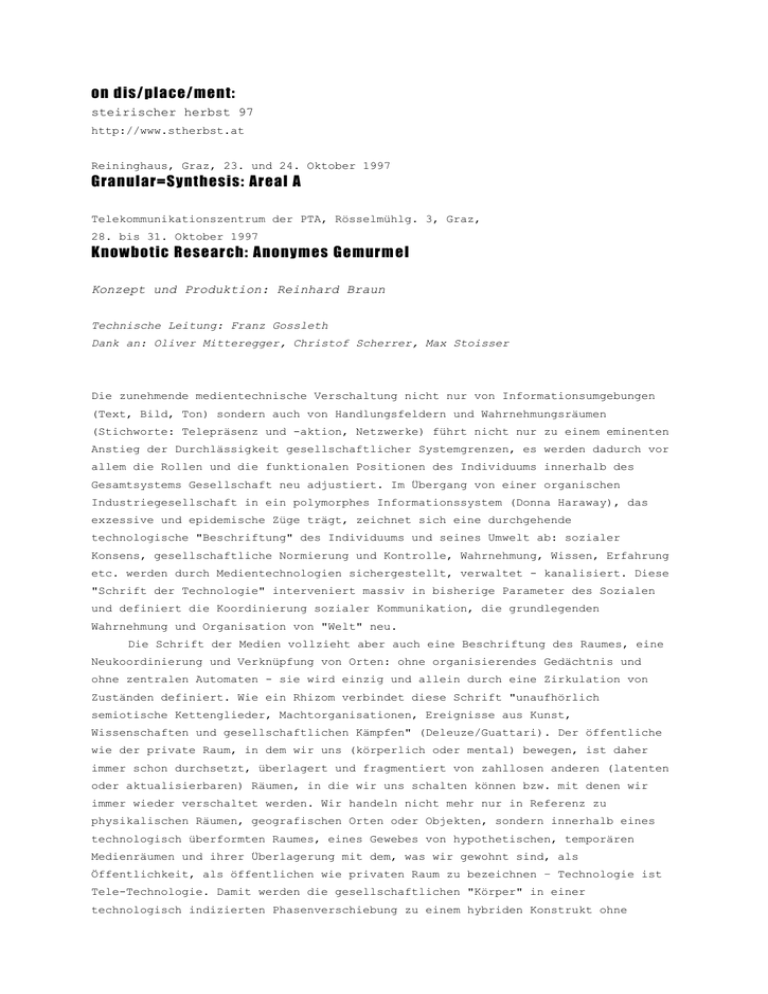
on dis/place/ment: steirischer herbst 97 http://www.stherbst.at Reininghaus, Graz, 23. und 24. Oktober 1997 Granular=Synthesis: Areal A Telekommunikationszentrum der PTA, Rösselmühlg. 3, Graz, 28. bis 31. Oktober 1997 Knowbotic Research: Anonymes Gemurm el Konzept und Produktion: Reinhard Braun Technische Leitung: Franz Gossleth Dank an: Oliver Mitteregger, Christof Scherrer, Max Stoisser Die zunehmende medientechnische Verschaltung nicht nur von Informationsumgebungen (Text, Bild, Ton) sondern auch von Handlungsfeldern und Wahrnehmungsräumen (Stichworte: Telepräsenz und -aktion, Netzwerke) führt nicht nur zu einem eminenten Anstieg der Durchlässigkeit gesellschaftlicher Systemgrenzen, es werden dadurch vor allem die Rollen und die funktionalen Positionen des Individuums innerhalb des Gesamtsystems Gesellschaft neu adjustiert. Im Übergang von einer organischen Industriegesellschaft in ein polymorphes Informationssystem (Donna Haraway), das exzessive und epidemische Züge trägt, zeichnet sich eine durchgehende technologische "Beschriftung" des Individuums und seines Umwelt ab: sozialer Konsens, gesellschaftliche Normierung und Kontrolle, Wahrnehmung, Wissen, Erfahrung etc. werden durch Medientechnologien sichergestellt, verwaltet - kanalisiert. Diese "Schrift der Technologie" interveniert massiv in bisherige Parameter des Sozialen und definiert die Koordinierung sozialer Kommunikation, die grundlegenden Wahrnehmung und Organisation von "Welt" neu. Die Schrift der Medien vollzieht aber auch eine Beschriftung des Raumes, eine Neukoordinierung und Verknüpfung von Orten: ohne organisierendes Gedächtnis und ohne zentralen Automaten - sie wird einzig und allein durch eine Zirkulation von Zuständen definiert. Wie ein Rhizom verbindet diese Schrift "unaufhörlich semiotische Kettenglieder, Machtorganisationen, Ereignisse aus Kunst, Wissenschaften und gesellschaftlichen Kämpfen" (Deleuze/Guattari). Der öffentliche wie der private Raum, in dem wir uns (körperlich oder mental) bewegen, ist daher immer schon durchsetzt, überlagert und fragmentiert von zahllosen anderen (latenten oder aktualisierbaren) Räumen, in die wir uns schalten können bzw. mit denen wir immer wieder verschaltet werden. Wir handeln nicht mehr nur in Referenz zu physikalischen Räumen, geografischen Orten oder Objekten, sondern innerhalb eines technologisch überformten Raumes, eines Gewebes von hypothetischen, temporären Medienräumen und ihrer Überlagerung mit dem, was wir gewohnt sind, als Öffentlichkeit, als öffentlichen wie privaten Raum zu bezeichnen – Technologie ist Tele-Technologie. Damit werden die gesellschaftlichen "Körper" in einer technologisch indizierten Phasenverschiebung zu einem hybriden Konstrukt ohne eindeutig lokalisierbare und umschreibbare Räume und Orte umgeformt. Medientechnologien generieren eine grundlegende kulturelle Transformation, die ihre Elemente (Individuen wie Lokationen) ständig an neue Orte versetzt, ver-rückt, in ein "Spiel" von Überlagerungen und Schichtungen, von Verschiebungen und Verdrängungen verwickelt: dis/place/ments. o n dis /pl ac e/ m e n t greift diese Umformung des gesellschaftlichen Raumes durch Massen/Tele/Hyper-Medien auf, die Verschiebung und Irritierung der unser Handeln bestimmenden Kontexte und Erfahrungszusammenhänge. Das Projekt stellt die Frage nach dem gesellschaftlichen Raum unter Medienbedingungen, die Frage nach dem mediatisierten Raum als Parameter kollektiver kultureller Praktiken. "Um zu eigenen Parametern zu kommen, muß man die Dinge, Bedeutungen und Kontexte entsprechend umbauen. Für den Ausbau der kommunikativen Perspektiven muß man Orte einer neuen Kunst [eines neuen Sozialen?] finden und erfinden. Das sind wohl heute eher Orte einer Intensität auf Zeit als Institutionen der Permanenz." (Knowbotic Research) Beide im Rahmen von o n dis /pl ac e /m e n t für den steirischen herbst 97 realisierten Projekte (siehe folgende Seiten) lassen sich explizit auf eine solche Problematisierung des mediatisierten Raumes (als Raum der Kunst wie des Sozialen) beziehen und konstruieren vorläufige, exemplarische Orte einer Intensität auf Zeit, hypothetische Orte von unwahrscheinlichen Synästhesien und (ästhetischen) Mutationen, Orte eines spezifischen Zusammenspiels von Bildern und Ereignissen, die sich auf die Vorherrschaft des technologischen Signifikanten beziehen. Sowohl A r e a l A wie A n o n y m e s G e m u r m e l zeigen auf exemplarische Weise, daß öffentliche Räume, bestehende wie konstruierte, nicht mehr als Orte oder Räume im klassischen Sinn gedacht und analysiert werden können, sondern als Knoten innerhalb dynamischer Systeme von medial indizierten und generierten Überlagerungen und Verschiebungen angenommen werden müssen. Sie sind zu hybriden Konstrukten mutiert, die einem ständigen dis/place/ment unterworfen und in ein hochmobiles Feld strategischer Entscheidungen eingebunden sind, ein Feld, in das sich das Individuum als soziales Konstrukt und Körper zunehmend verwickelt sieht. on dis/place/ment: styrian autumn 97 http://www.stherbst.at The increasing link up of media technology not only with information environments (text, image, sound), but also with fields of action and spaces of perception (telepresence and teleaction, networks) is not only causing an immense increase in the permeability of the borders of social systems, also the possible role and location of the individual within the overall system of society is being readjusted. In the transition from an organic industrialized society to a polymorph information system (Donna Haraway) that bears excessive and epidemic traits, a complete technological "inscription" of the individual and its environment is becoming apparent. Social consensus, social standardization and control are guaranteed by means of media technologies. This "writing of technology" is thus transforming numerous parameters of the social sphere, redefining the co-ordination of social communication, the fundamental perception and organisation of "world". But the writing of the media also inscribes space, recoding and linking locations. The public and private space in which we move (physically or mentally) is always interspersed, overlapped and fragmented by numerous other (latent or updatable) spaces that we can switch into and with which we are repeatedly linked up. We no longer act in reference to physical spaces, geographical locations or objects but rather within a technologically efformed space, a fabric of hypothetical, temporary media spaces and their overlapping with what we are accustomed to calling the public sphere, public and private space — technology is teletechnology. In this way the social "bodies" in a technologically indicated shift of phase are transformed into a teletechnologically interwoven construction with no unambiguously localizable and circumscribable spaces or locations. Media technologies indicate a fundamental cultural transformation that is continuously relocating its elements, dis-placing them and involving them in a "game" of shifts and dislocations — dis/place/ments. on d i s/ p la c e/ m en t focuses on this transformation of social space by the mass/tele/hyper media, the shift and irritation of the contexts and connections of experience that determine our action. The project asks about the social space under media conditions, about mediatized space as a parameter of collective cultural practises. "In order to set up one's own parameters it is necessary to reconstruct the objects, meanings and contexts accordingly. In order to expand the communicative perspectives it is necessary to find and invent locations of a new art [a new social sphere?, R. B.]. Today, such locations are sites of temporary intensity rather than institutions of permanence." (Knowbotic Research) Ar ea l A as well as An o n y m ou s M ut t er i ng created as part of on dis/pace/ment for the steirischer herbst festival 97 can be referred to this focus on mediatized space (as space of art and the social sphere) and construct exemplary (non-) locations of a temporary intensity. Both projects ask about the possible locations of the subject in view of the technological acceleration of perception and production and social traffic as a whole, i.e. the question as to possible artistic strategies of constructing adequate fields and options of action within the scope of this acceleration. But they also ask about the constitution and manifestations of social "bodies", their composition, their forms of exchange, their fields of operation, contexts, exclusions, their disappearance. Both Areal A and Anonymes Gemurmel show exemplarily that public spaces, existing constructed spaces, can no longer be conceived and analysed as locations or spaces in the classical sense, but must rather be taken to be dynamic systems of media-indicated and media-generated overlaps and shifts. They have mutated to become hybrid spaces subject to constant dis/place/ment that form a highly mobile field of strategic decisions in which the individual is increasingly involved as a social construction and body.
